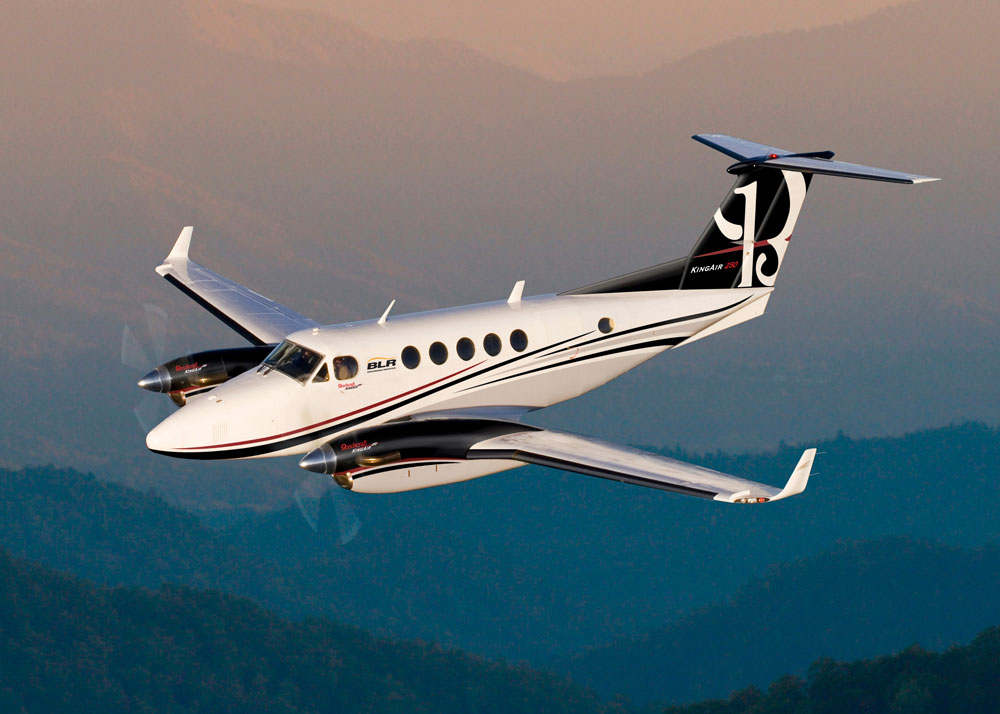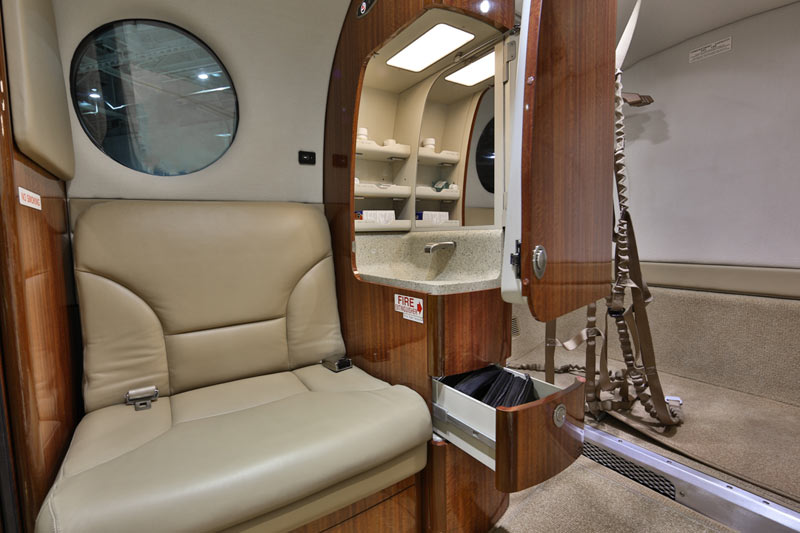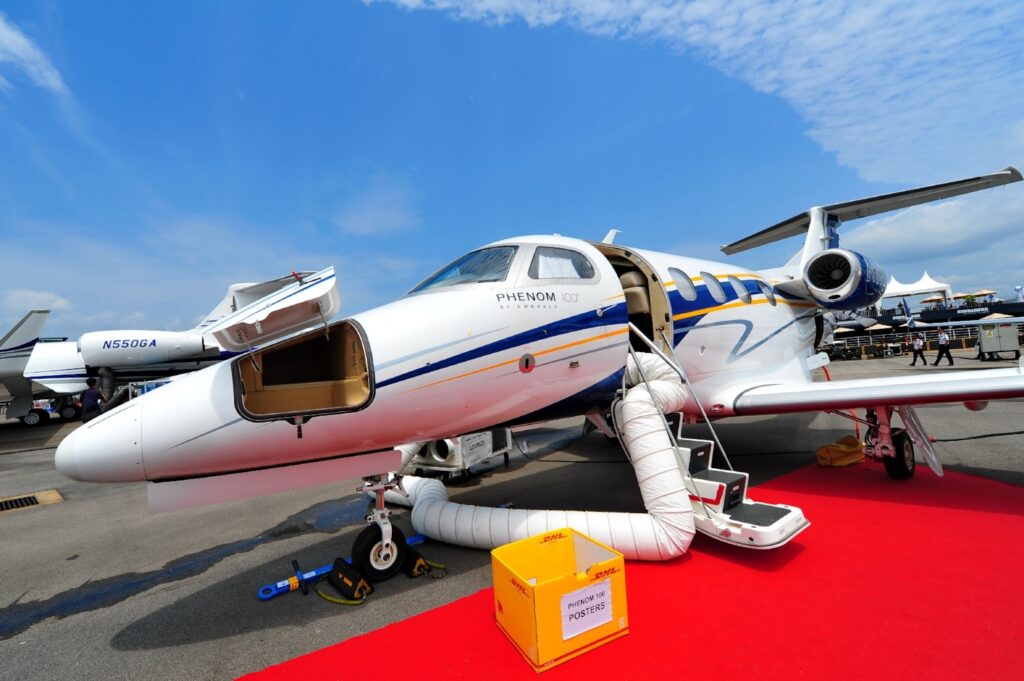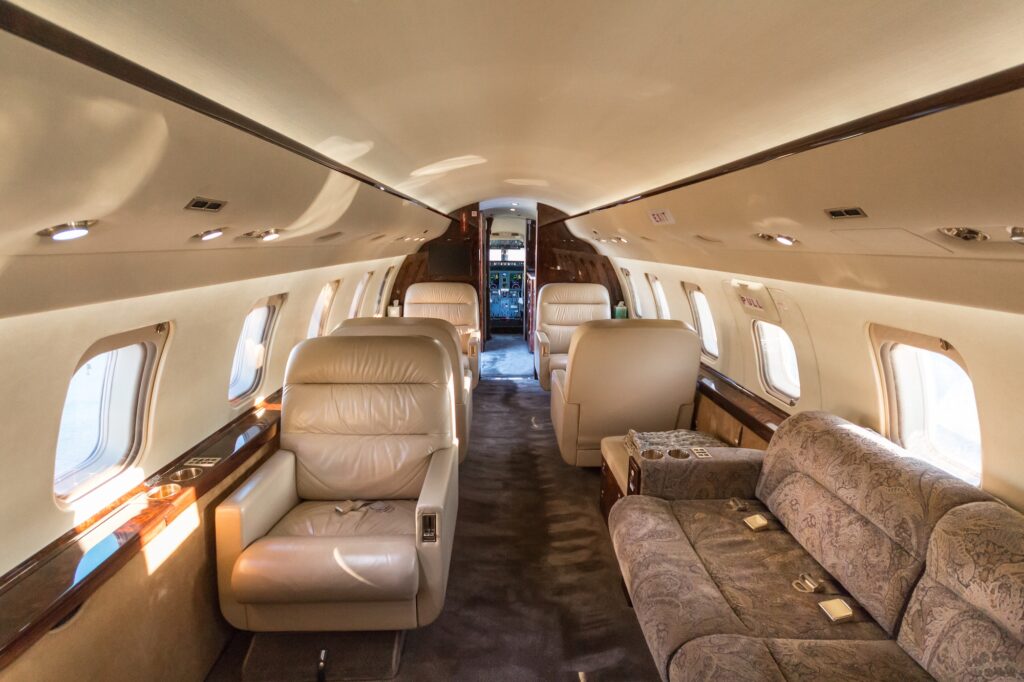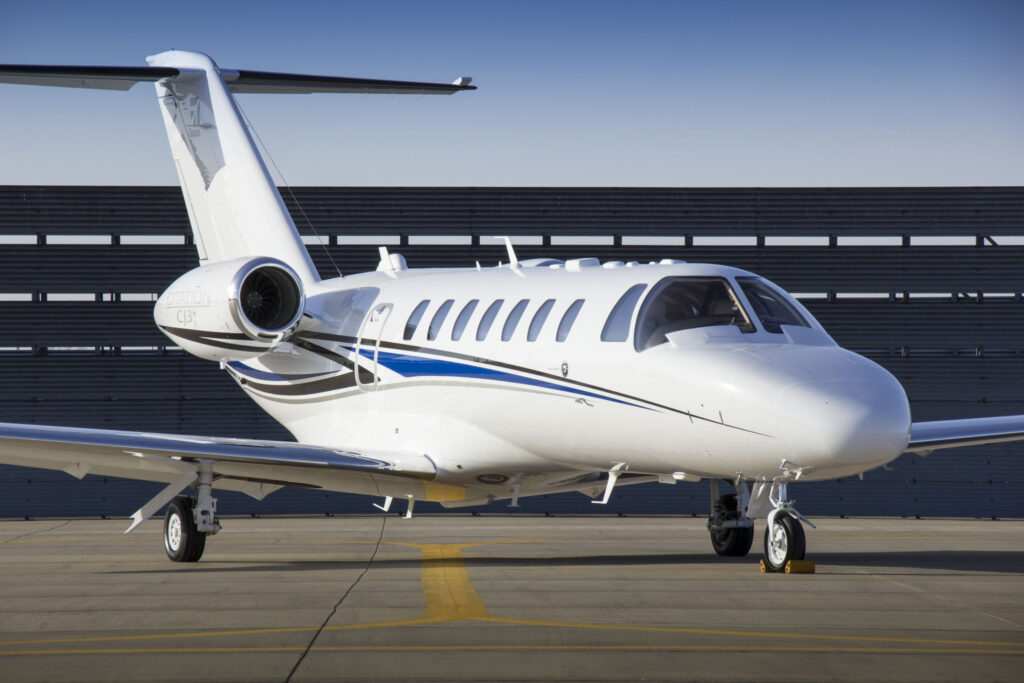One of the biggest considerations for aircraft buyers who don’t want to hire a full flight department is whether or not the aircraft qualifies to be flown with a single pilot. While some operators fly with two pilots for safety and redundancy reasons, the following planes are among our favorites for a number of reasons.
King Air 250

The King Air 250 is part of the most popular turboprop line of all time. According to Forbes, “for the past five decades [the King Air] has continued to dominate the market, outselling all of its turboprop competitors combined.”
The King Air 250 is one of the most technologically advanced turboprops on the market, featuring the Collins Pro Line Fusion avionics suite with touchscreen drag-and-drop technology, synthetic vision and eyes-forward graphical map interactivity. From here on out, all King Air 250s will come equipped with the Pro Line Fusion – the next-gen Rockwell Collins cockpit. Landmark Aviation is offering installation of the Fusion system as an upgrade to older model King Airs.
As a successor to the 200 series aircraft, King Air 250s come equipped with composite props that are lighter, quieter, and cost less to maintain than traditional propellers. Beechcraft also included carbon fiber blended winglets, increasing lift, reducing drag and improving takeoff, climb, cruise and landing performance. The King Air 250 will get you to your destination only a few minutes later than its light jet competitors, with a cruise speed of around 308 knots. The 250 burns less fuel and requires shorter runways than its light jet competitors, and performs significantly better in hot and high conditions, making it the perfect aircraft to get to some of the more challenging airports.
Pilatus PC-12 NG
Pilatus’ PC-12 NG is unique in its popularity as a single-engine turboprop. The PC-12 “Next Generation” comes equipped with a more powerful Pratt & Whitney engine than the original PC-12, as well as modified winglets, improving climb performance and maximum cruise speed. Pilatus also upgraded the NG with a Honeywell Primus Apex glass cockpit, complete with automatic pressurization control and cursor controlled inputs to the navigation system.
What sets Pilatus aircraft apart from its competitors is the precision engineering and construction that the Swiss are known for, and its 17-foot long, 5-foot wide cabin (available with a BMW-designed interior), which rivals some midsize business jets. The PC-12’s ability to move more than 1,200 pounds of payload over 1,000 miles against the strongest headwinds at close to 260 knots allows the aircraft to be used for a multitude of purposes. From passenger transportation and cargo shipments to U.S. Air Force special operations missions, the single-engine, single-pilot PC-12 NG can handle just about anything.
[ulp id=’xkA7bnsbSMSAnwAm’]
Citation M2
Cessna’s Citation M2 was introduced to the market as an update for the CJ1+, targeting owner-operators ready to step up from the Citation Mustang. Advancements include increased cruising speed, improved takeoff and landing performance, a redesigned cabin, reduced operating costs and improved avionics. The advanced Intrinzic Flight Deck powered by Garmin’s G3000 avionics system includes touch screen, high-resolution displays which, in turn, improve situational awareness for pilots.
The M2’s comfortable cabin includes a four-place club configuration, ergonomic design and modern interior, with seating for up to seven passengers. Additional amenities include a belted lavatory, redesigned interior storage for cups and other personal items, seats that move to cater to any passenger’s comfort level and fold-out work tables. According to Flying Mag, “the interior was redesigned by the same team that is working on Cessna’s two large-body models, the Latitude and larger Longitude, so the quality of the materials and workmanship in M2 is as good as you’ll see in Cessna’s in-development big-bucks bizjets.”
Citation CJ3+

The CJ3+, which Cessna has given the tagline “Efficient and Dependable,” is the first Citation Jet to be equipped with Garmin’s G3000 avionics system. The CJ3+ progression of single-pilot jets from Cessna operates with a faster cruising speed and improved takeoff and landing performance than its predecessor; its takeoff and landing capabilities are among the best in its class. The CJ3+’s 53’9” wingspan produces more lift with less drag and delivers greater speed, range and fuel efficiency than previous Citation Jets.
In standard configuration, the nearly 16-foot long cabin seats six passengers in well-appointed comfort. Although the CJ3+ comes standard with seating for six passengers, an additional forward, side-facing seat in place of the standard large galley is available as an option. The CJ3+ cabin comes with a newly styled interior, as well as Cessna’s new “Clarity” cabin management system, LED lighting throughout and the increasingly popular in-flight Wi-Fi, improving upon the Citation Jet’s strong reputation for passenger comfort.
Premier 1A

Hawker-Beechcraft’s Premier was created to compete with Cessna’s successful CJ line, which, at the time consisted of only the CJ, CJ1 and CJ2 models. Hawker-Beechcraft’s goal was to create a single-pilot business jet with minimal operating and acquisition costs, while maintaining high performance standards.
The Premier 1A has one of the largest cabins among jets of its size, offering half a foot more headroom than other light jets. The fuselage is made of a high-strength carbon fiber/epoxy honeycomb composite, making it one of the safest planes on the market. The only differences between the Premier 1 and Premier 1A are improved avionics and brakes, and a redesigned cabin.
The Premier 1A’s unique, swept wings and Rolls-Royce engines allow it to compete with some of the fastest light jets in the industry, while maintaining low operating costs. Like its predecessor, the Premier 1A is known for its affordability, comfort and reliability, although several pilots have told us that it’s not a plane for amateurs (or people who like to fly slowly).
Charlie Bravo’s Single-Pilot Planes For Sale
[fusion_portfolio layout=”carousel” picture_size=”default” text_layout=”unboxed” one_column_text_position=”below” equal_heights=”no” portfolio_title_display=”title” portfolio_text_alignment=”center” filters=”no” pull_by=”category” cat_slug=”single-pilot-planes” pagination_type=”none” hide_url_params=”off” offset=”0″ orderby=”date” order=”DESC” content_length=”no_text” excerpt_length=”10″ strip_html=”yes” carousel_layout=”title_below_image” scroll_items=”1″ autoplay=”no” show_nav=”yes” mouse_scroll=”no” hide_on_mobile=”small-visibility,medium-visibility,large-visibility”/]
Phenom 300
Embraer’s Phenom 300 was the most delivered business jet in both 2013 and 2014 for a reason. The Phenom 300 was created after Embraer realized that fans of their successful Phenom 100 would like a larger aircraft, and according to Flying Mag, “it is, in essence, Embraer’s attempt to stretch the limits of the light jet segment by creating an airplane with best-in-class performance, comfort and utility while keeping operating costs at turboprop levels.”
Its best assets are in line with the Phenom 100: cabin comfort, speed, reliability, and low operating costs. The increased size allowed Embraer to nearly double the max fuel weight, leading to an extended range of more than 1,900 miles, making it the perfect aircraft for a flight from Austin to New York City. Its range, which is among the top of the light jet class, is what sets it apart from the competition. Operators like NetJets find the reliability to be exceptional, and the fleet support from Embraer, which has its roots as a regional airline supplier, is top-notch.
Encore+
Cessna’s Citation Encore+ is the largest business jet that can be flown by a single pilot. The Encore is one of the most versatile private jets in its class, and its successor takes it to another level. Cessna’s Citation Encore+ improved upon the Encore’s payload significantly, and upgraded the avionics system by implementing the Collins Pro Line 21. Cessna also incorporated a FADEC (Full Authority Digital Engine Control) to reduce pilot workload.
These improvements allow the Encore+ to carry heavier loads for longer distances, while still managing to reduce operating costs. More specifically, the Encore+ has the ability to carry five passengers from coast to coast with just one stop. The Encore+’s unique combination of range, speed and comfort is what makes it one of the most versatile private jets in its class.
Want to know more about single-pilot planes? Check out our comprehensive Buyers’ Guide for Single-Pilot Planes by clicking below.
[ulp id=’xkA7bnsbSMSAnwAm’]
Now that you’ve read up on some of our favorite single-pilot jets, check out our blog on some of the fastest single-pilot jets in the world.

